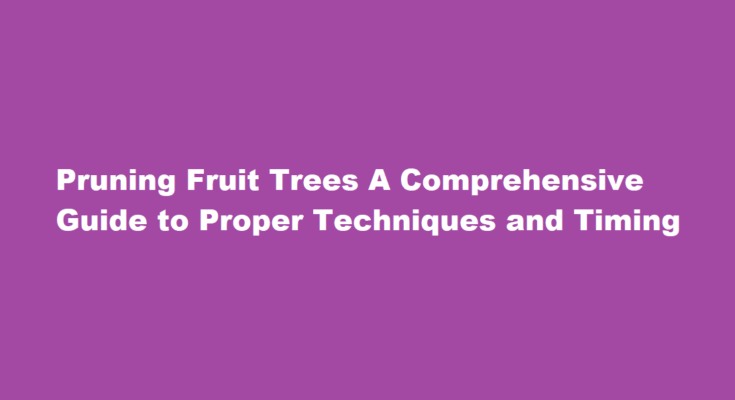Introduction
Pruning is a crucial horticultural practice that promotes healthy growth, maximizes fruit production, and maintains the structural integrity of fruit trees. When done correctly, pruning can enhance sunlight penetration, improve air circulation, and remove dead or diseased wood. However, improper pruning can harm the tree, leading to reduced yields and increased vulnerability to pests and diseases. In this article, we will provide a step-by-step guide on how to properly prune a fruit tree, ensuring its long-term health and productivity.
Understand the Importance of Pruning
Pruning is not a random act of tree cutting; it is an art and science that requires a clear understanding of the tree’s biology. Fruit trees need proper pruning to eliminate competing branches, stimulate new growth, and direct energy toward fruit production. Regular pruning also helps the tree maintain an open canopy, which prevents overcrowding and enables sunlight to reach all parts of the tree.
Choose the Right Time
Timing is critical when it comes to pruning fruit trees. The best time for pruning depends on the type of tree and the region’s climate. Generally, it’s best to prune deciduous fruit trees during late winter or early spring before bud break. On the other hand, evergreen fruit trees can be pruned during late winter or early summer when growth is less vigorous. Avoid pruning during the fall, as it can stimulate new growth that may be damaged by winter frosts.
Gather the Proper Tools
Before you start pruning, ensure you have the right tools to make clean cuts. Essential pruning tools include sharp bypass pruners for smaller branches, loppers for medium-sized branches, and a pruning saw for thicker limbs. Make sure your tools are clean and well-maintained to minimize the risk of introducing diseases to the tree.
Start with Dead and Diseased Wood
Begin the pruning process by removing any dead, damaged, or diseased wood. These branches can be a gateway for pests and diseases, compromising the overall health of the fruit tree. Make clean cuts just outside the branch collar (the swollen area where the branch meets the trunk), as this will aid in the healing process and prevent the spread of infection.
Remove Suckers and Water Sprouts
Suckers are vigorous shoots that grow from the base of the tree, while water sprouts are fast-growing vertical shoots. Both types of growth divert energy from fruit production and should be removed. Use sharp pruning shears to cut suckers at the base, and prune water sprouts back to the branch they originated from.
Thin Out Excess Branches
Overcrowded branches limit sunlight penetration and air circulation, leading to a higher risk of disease. Selectively remove crossing branches and those growing inward toward the center of the tree. Aim to maintain an open canopy that allows light to reach all parts of the tree, promoting even fruit development.
Shape the Tree
Pruning can be used to shape fruit trees, especially during their early years. The desired shape will depend on the tree type (e.g., central leader for apples, open vase for peaches). Encourage a strong central leader or main trunk by removing competing leaders, and maintain well-spaced scaffold branches that form a balanced framework.
FREQUENTLY ASKED QUESTIONS
What is the best time to prune fruit trees?
There are many reasons for pruning fruit trees. The best time to prune fruit trees is late winter into early spring when it will least affect winter hardiness and tree health. Summer pruning in late July or August is another time when pruning can be performed, but severe pruning at this time will weaken the tree.
What is the proper tree pruning technique?
A proper pruning cut does not damage either the branch bark ridge or the branch collar. A proper cut begins just outside the branch bark ridge and angles down away from the stem of the tree, avoiding injury to the branch collar .
Conclusion
Properly pruning a fruit tree is essential for its health and productivity. Understanding the tree’s biology, choosing the right time, using the correct tools, and following a systematic approach will help you achieve optimal results. Regular pruning will ensure a bountiful harvest, improve the tree’s resistance to diseases, and enhance its overall longevity. So, grab your pruning tools and get ready to cultivate healthy, thriving fruit trees in your garden. Happy pruning!
Read Also : Building a Robust Social Media Presence for Your Brand Strategies for Success



